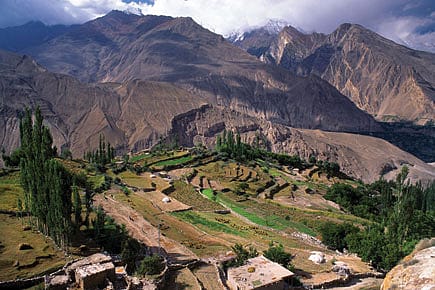And the Mountains Echoed

Images of travel seduce me like no others; fill me with a sense of paradises lost, of places in which I might have immersed myself. Of all those that have beckoned, the Hunza Valley is the most seductive, but it lies just outside my reach, across the Line of Control in Kashmir.
How tenuous are these lines on maps. 'Intangible, yet maddeningly granitic—borders. They unlock strange panoramas in our collective psyche; the borders of identity, of inward- outerness,' wrote Paul Salopek.
The Hunza Valley famously inspired Lost Horizon, James Hilton's novel about a Shangri La. Here, Levison Wood walked through 'fields of spinach and cabbage and orchards of apricots, cherries and walnuts.' In the current dispensation of lines and borders, the Hunza is part of Gilgit-Baltistan, under the administration of Pakistan. Yet, in 2013, I spent a few days in Turtuk, India's northern-most village, where my host proudly proclaimed himself a 'Balti', born just after the war of 1971, in which four Balti villages came under Indian rule. Children walked to school along waterways of jade glacial melt, and fields of wheat bent to breezes coming off the world's highest peaks.
Wood began his traverse of the Himalayas north of Gilgit, from Afghanistan's Wakhan corridor, 'the very start of the Greater Himalaya range, where the Hindu Kush clashes in a violent upsurge with the Pamirs, and beyond them the Karakoram'. A narrow valley bordered by Tajikistan, China and Pakistan, it is the wildest, most remote and inaccessible part of Afghanistan. It is this difficulty of access that gives the book some of its most thrilling passages—of Kabul, under siege and armed to the teeth; of a Moldovan helicopter pilot who resembled a Bond villain and usually flew gangsters around Kabul; of negotiating with a rascally Kyrgyz chieftain for pack animals.
2026 New Year Issue
Essays by Shashi Tharoor, Sumana Roy, Ram Madhav, Swapan Dasgupta, Carlo Pizzati, Manjari Chaturvedi, TCA Raghavan, Vinita Dawra Nangia, Rami Niranjan Desai, Shylashri Shankar, Roderick Matthews, Suvir Saran
Heading south, Wood had his tryst with the real Silk Road, and its successor, the engineering feat called the Karakoram Highway. In the Himalayas, though, human endeavour inevitably bows to tectonic reality, and a 20 km section of road had given way to Attabad Lake, formed when a landslide blocked the Hunza river. Passage was made possible by the Pakistani version of our jugaad, a boat improvised from planks, and steered from a 'rickshaw which had been welded onto the deck—multicoloured windshield and all; it looked ridiculous'.
Attempting to enter Indian Kashmir—'where for months I had dreamt of going', Wood had to yield to our South Asian reality, to the Pakistan army telling him, "This is the line of control. Our enemy is there and we cannot let you go. It is too dangerous".
Thus began the first of Wood's backtracking trips: determined to trace as nearly unbroken a path as possible, he drove down the Karakoram Highway to Abbottabad, crossed into India via the Wagah border, then up to Srinagar; to hack a path back up to the Line of Control, this time from the Indian side.
His second backtrack was far more dramatic, a testament to his tenacity. Barely surviving a road accident in Nepal, Wood received first-aid in a village hospital, was evacuated to Kathmandu by helicopter, and then flown home to the UK for surgery and physiotherapy. Fifty days after the jeep went off the cliff, his arm reinforced with metal plates and screws, he flew back from Heathrow to Kathmandu, to resume his journey from the wreck of the jeep whose brakes had failed.
Travel writing does not survive on adrenaline alone, though, and the traveller is bound to write of the people he meets, and the societies they populate. Writing of India and Nepal, the territories we inhabit, Wood is banal, sometimes embarrassingly wrong. The rice fields of Nepal are not terraced, but 'trellised', and the ancient Indian university is 'Nalinder'; in Haridwar, women bathe in red silk saris, and boys have their first haircuts, 'a Hindu rite of passage in a child's seventh year'.
While mocking gap-year students 'who hung around the Dalai Lama's monastery in Dharmsala', Levison snagged an interview with His Holiness, and bookended that darshan with a visit to a lama in Bhutan.
If you can skim through these pedestrian sections without being too irked, Walking the Himalayas provides the vicarious pleasure of a journey some of us may have dreamed of, but few will undertake. And if you have the time, also pick up this account of the first such journey undertaken—First Across the Roof of the World: The First-ever Traverse of the Himalayas, 5,000 Kilometres from Sikkim to Pakistan by Peter Hillary and Graeme Dingle (1982).
